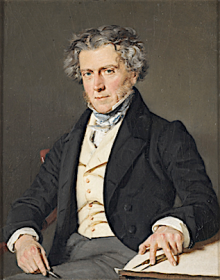
Charles Robert Cockerell [also known as C.R. Cockerell] was born in London, England on 28 [or 27 - sources differ*] April 1788 [1]. He trained as an architect in the office of his father, Samiel Pepys Cockerell (1753-1927) from the age of 16, and in the office of Sir Robert Smirke in 1809-10. From 1810 to 1817 he travelled throughout Greece, Italy and neighbouring countries. Following his return to London in June 1817 he established an architectural practice in in Old Burlington Street, Mayfair. He subsequently designed a number of commercial buildings in the city including banks and office.
From 1841 to 1856 he was professor of architecture at the Royal Academy in London. He was also surveyor of St Paul's Cathedral from 1819, and architect to the Bank of England from 1833. He was elected an Associate of the Royal Academy (ARA) in 1829 and a Royal Academician (RA) in 1836. In 1848 he was the first recipient of the Royal Gold Medal of the Royal Institute of British Architects.
Cockerell wrote extensively on art, architecture and archaeology.
He retired as an architect in 1859 and died at his home, 13 Chester Terrace, Regent's Park, London, on 17 September 1863.
____
[1] The Dictionary of National Biography gives the date as 28 April 1788.
During the 1830s Cockerell designed three major university buildings: Cambridge University Library (1829-42), the Ashmolean Museum, Oxord (1841-45), and the Taylor Institution, Oxford (1845. Other work included Langton House, Langton, Long Blandford, Dorset (1827-33); Holy Trinity Church, Hotwell Road, Bristol (1829-30); Additions to Blaise Castle House, Henbury, near Bristol (1832); London and Westminster Bank, Lothbury, London (1837); Squire Law Library, Old School, Cambridge (1837-42); Sun Fire and Life Assurance building, Threadneedle Street, London (1839-42); Chapel, Killerton Park, Devon (1840-41); Cavendish House, Oxfordshire (1842-45); Branxhes of the Bank of England in Bristol, Liverpool and Manchester (1844-47); Bank Chambers, Cook Street, Liverpool (1846-49); St. George's Hall, Liverpool, with Frederick Pepys Cockerell (1847-56); London and Globe Insurance building, Dale Street, Liverpool (1855-57).
____
For a detailed list of architectural projects by Charles Robert Cockerell see Colvin, 4th edition, 2008 pp. 262-265
Aitchison, George. ‘Charles Robert Cockerell, RA: second President of the Royal Institute of British Architects, 1860-61’. Royal Institute of British Architects. Transactions 2nd series vol. 6, 1889/1890, pp. 255-261
Avery, Derek. Victorian and Edwardian Architecture. London: Chaucer Press, 2003
Bordeleau, Ann. Charles Robert Cockerell, architect in time : reflections around anachronistic drawings. Farnham: Ashgate, 2014
Broucke, Pieter B. F. J. The archaeology of architecture : Charles Robert Cockerell in Southern Europe and the Levant 1810-1817. New Haven : Yale Center for British Art, 1993
Carr, Gerald L. ‘C R Cockerell's Hanover Chapel’. Society of Architectural Historians. Journal vol. 39, no. 4, December 1980 pp. 265-285
‘Chronological list of designs and drawings by the late Charles Robert Cockerell, Esq, RA, selected to be exhibited at the Royal Institute of British Architects, November 1863’ Royal Institute of British Architects. Proceedings 1st series 1st series vol. 17, 1863-1864, pp. viii-x, 380-382
Cockerell, Robert Pepys. ‘Life & works of Charles Robert Cockerell: 1. Early life & studies’. Architectural Review vol. 12, 1902, pp. 43-47
Cockerell, Robert Pepys. ‘Life & works of Charles Robert Cockerell: 2. Principal buildings’ Architectural Review vol. 12, 1902, pp. 129-146
Collingwood, F. ‘Charles Robert Cockerell (1788-1863), architect, archaeologist and artist’. The Builder 13 September 1963 p. 514
Colvin, Howard, A Biographical Dictionary of British Architects 1600-1840. New Haven, Connecticut and London: Yale University Press, 4th edition, 2008
Directory of British Architects 1834-1914. Compiled by Antonia Brodie, et al. Volume 1: A-K. London; New York: British Architectural Library, Royal Institute of British Architects/Continuum, 2001
Dodd, E. M. ‘Charles Robert Cockerell’ in Victorian Architecture, edited by Peter Ferriday. London: Jonathan Cape, 1963 pp. 103-121
‘Great British architects: Charles Robert Cockerell (1788-1863)’. Country Life vol. 204, no. 31, 4 August 2010 pp. 52-53
Harris, J. ‘C. R. Cockerell's 'Ichnographica Domestica'’. Architectural History vol. 14, 1971 pp. 5-29
Knox, Tim. ‘Cockerell's model for Langton: a house for the 'Dorsetshire Nimrod'’. Georgian Group journal 1993 pp. 62-67
Kohane, Peter. Architecture, labor and the human body : Fergusson, Cockerell and Ruskin. Ph.D. dissertation, University of Pennsylvania, 1993.
Mulvin, Lynda. ‘Charles Robert Cockerell's encounter with Ireland: drawings, observations and buildings’. Irish Architectural & Decorative Studies vol. 12, 2009, pp. 130-157.
‘Newly discovered drawings by C R Cockerell for Cambridge University Library’. Architectural history vol. 26, 1983, pp. 87-91, plates 44-57.
‘Obituary’. The Builder vol. 21, 26 September 1863 pp. 683-685, 705
‘Obituary’. Gentleman's Magazine vol. 15, 1863, pp. 785-791
Pearce, Susan M. and Ormond, Theresa. Charles Robert Cockerell in the Mediterranean : letters and travels, 1810-1817. Woodbridge : Boydell, 2017.
‘Obituary’. Illustrated London News vol. 43, 1863, pp. 341-342
‘Obituary’. Royal Institute of British Architects Transactions 1863/4, pp. 1-3, 17-26
‘Reflections on the Ashmolean Museum’. Oxford art Journal no. 1, 1978 pp. 47-49 [Architect: (1845) C. R. Cockerell]
Smirke, Sydney. ‘Some account of the professional life and character of the late Professor C R Cockerell, RA, Fellow, and late President RIBA’. Royal Institute of British Architects. Transactions 1st series vol. 14, 1863/1864, pp. 17-28, viii-x
Watkin, David John. ‘The life and work of C.R. Cockerell’. London: Zwemmer, 1974.